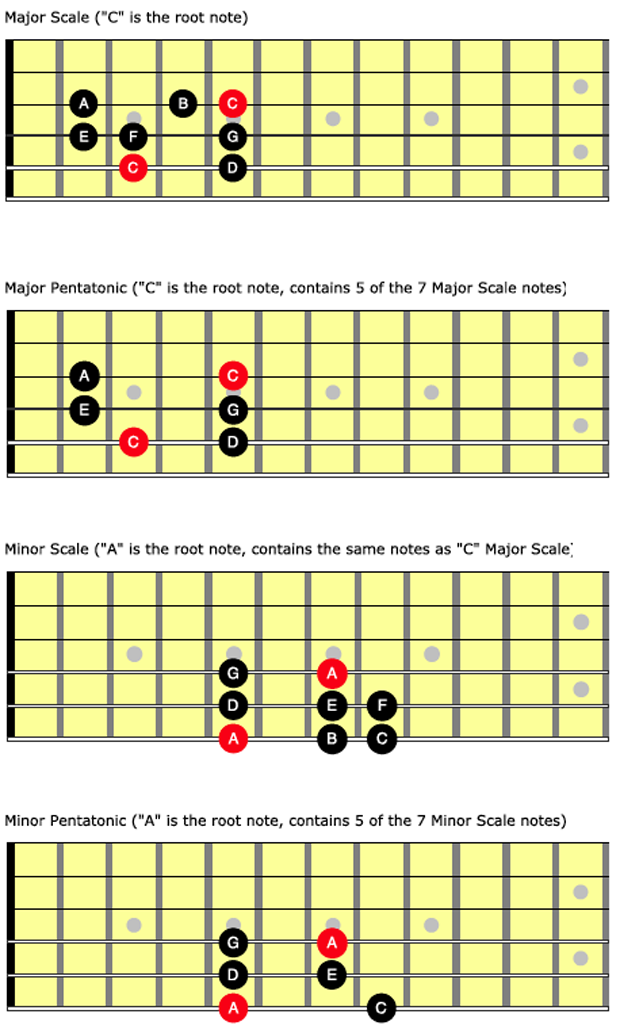Knowing "a Ton of Scales" Made Simple, Part 1

We all know the true measure of an accomplished guitarist is not dependent upon how many scales he or she can blaze through.
Instead, it's much more enjoyable to hear a player who has great command and control over just one or two scales. Many of the greats did not possess encyclopedic knowledge of music theory, and it didn't seem to hinder their progress or creativity.
Jimi Hendrix might not have been aware of the Lydian dominant scale—but does that diminish his ability? I think we all know the answer to that question. The man internalized the blues and pentatonic scales to the point where every note he played sounded so tasteful, deliberate and powerful.
With all of that being said, I do want to talk about how knowing many scales can be a much less daunting proposition than you might think. The key is in understanding how various concepts in music theory are connected to each other. The more you go down this path, the more you'll realize no piece of music theory truly functions in isolation. And it is these connections that will make the learning of various scales relatively painless.
Let's start with the concept of modes. Without getting stuck in the music theory weeds, modes are essentially scales. You can play them over an appropriate chord progression and they will help guide you through your improvisations. What makes modes unique is their relationship with what is sometimes referred to as a parent scale.
The best example of this is the major scale. You might've heard the saying that the major scale is the "mother of all scales." This doesn't mean it's the coolest scale, but it is an accurate description of its role in modal structure and music theory as a whole. The role is that of a parental figure.
Some of you may know that all music intervals are derived from the clean and pristine numbering system of the major scale. It's a seven-note scale that is simply numbered 1, 2, 3, 4, 5, 6, 7. The eighth note is called the octave, which is always the same note as the root, just higher in pitch. Every other scale that exists will ultimately be compared back to the major scale.
All the latest guitar news, interviews, lessons, reviews, deals and more, direct to your inbox!
For example, the melodic minor scale is almost identical to the major scale, except for the third note in its sequence. Because this third note deviates from our reference point (the major scale), we can't simply label it as "3." Instead, we refer to it as a flat 3rd (or minor 3rd) to indicate that it is a half step lower in pitch than the major scale's third note. This is how the entire intervallic system is constructed, all relating back to the major scale. This example is illustrated in the diagrams below.


Getting back to modes, the major scale also acts as a parental figure in modal construction. Let's say we're playing the major scale in the key of C. The seven notes we'll play will be C, D, E, F, G, A, B. Remember, this is based on "C" being the root note, or the tonal center. It is the focal point of resolution. What if we decided to use a different note as the tonal center while maintaining the same family of seven notes? This is the crucial component to understanding the nature of modes.
Let's now use "A" as the root and see what happens. Those same seven notes that now orbit around the tonal center of "A" become the minor scale (also known as the Aeolian mode or natural minor). So you see, the minor scale is not considered a parent scale in this context, which might surprise some of you.
In today's climate, we're all used to the major, minor and pentatonic scales being front and center in our musical landscape. But the natural minor and pentatonic scales play a somewhat subordinate role and can be easily derived simply from the major scale. Think about it this way: The natural minor scale can always be found within a major scale by shifting the tonal center to the sixth note in the major scale's sequence.
And the minor pentatonic scale is simply a shortened version of the natural minor scale (five notes instead of the full seven). Likewise, the major pentatonic is basically the major scale—minus two notes. This eases the burden of having to memorize four individual scales and instead helps us to use a more cohesive and unified approach.
Take a look at how this concept might look in the diagrams below.

In my next column, we'll use this approach to take on what would have been an overwhelming task, but now might seem more manageable: the introduction to more than 20 different scales. To be continued ...
Chris Breen is a New Jersey-based guitarist with 14 years of experience under his belt. He, along with his brother Jon (on drums) started the two-piece metal project known as SCARSIC in 2011. Due to a lack of members, Chris tracked guitars, bass and vocals for their self titled four-song demo (available on iTunes, Spotify and Rhapsody). They have recently been joined by bassist Bill Loucas and are writing new material. Chris also is part of an all-acoustic side project known as Eyes Turn Stone. Chris teaches guitar lessons as well (in person or via Skype). If you're interested in taking lessons with Chris, visit BreenMusicLessons.com for more info.
